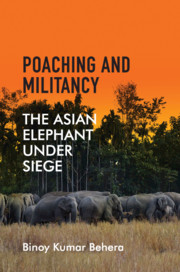5 - Future of the Asian Elephant
Published online by Cambridge University Press: 23 November 2018
Summary
According to Megasthenes, ambassador from the Seleucid Empire to the Mauryan court in the third century BC, Chandragupta Maurya's army of 30,000 cavalry and 6,00,000 infantry included 9,000 war elephants. Elephantry in the military was first practised in India, spread to southeast Asia and then went west on to the Mediterranean, as Greek king Pyrrhus and Hannibal of Carthage were among those who engaged them. As mentioned earlier, Kautilya's Arthashastra mentions that elephants found in the forests of present-day Odisha were best suited for war. Interestingly, Alexander's Admiral Onescritus is on record for having said that the elephants of Taprobane, known as Sinhala thereafter and Ceylon later, were ‘bigger, more fierce, and furious for war service than those of India's’, a statement corroborated by Megasthenes. Greek writer Aelian mentions export of Sinhala elephants from around 200 BC to Kalinga—the place in India where the best elephants came from.
During the reign of Sinhalese kings, it was a major crime in Sri Lanka to kill elephants, the punishment for which was death. Elephants were thereby well protected. With the onset of colonialism, however, elephants came to be declared as an agricultural vermin and there was a bounty for those who killed them. Needless to say, tuskers were killed in great numbers for sport. Unlike India, that had vast forests for elephants to retreat to, Sri Lanka did not give them the chance and they were decimated to the extent that tuskers were more or less completely liquidated. Today, in the land which produced the best male war elephants, the vast majority of whom bore tusks, the percentage of ivory-bearing elephants in the male elephant population is just 7 per cent, and in the total elephant population, an insignificant 2 per cent. Ironically, it is because male elephants in Sri Lanka today are almost entirely tuskless makhnas that poaching for ivory has ceased to be an issue of concern.
There is an important lesson here. Of the three sub-species of the Asian elephant, it is the Sri Lankan, aptly named Elephas maximus maximus, that is the largest. The Sri Lankan elephants of today are, however, believed to be smaller than those that are depicted in pictures to have been exported back in 200 BC, or for that matter those photographed in the nineteenth century
- Type
- Chapter
- Information
- Poaching and MilitancyThe Asian Elephant under Siege, pp. 114 - 138Publisher: Cambridge University PressPrint publication year: 2019

